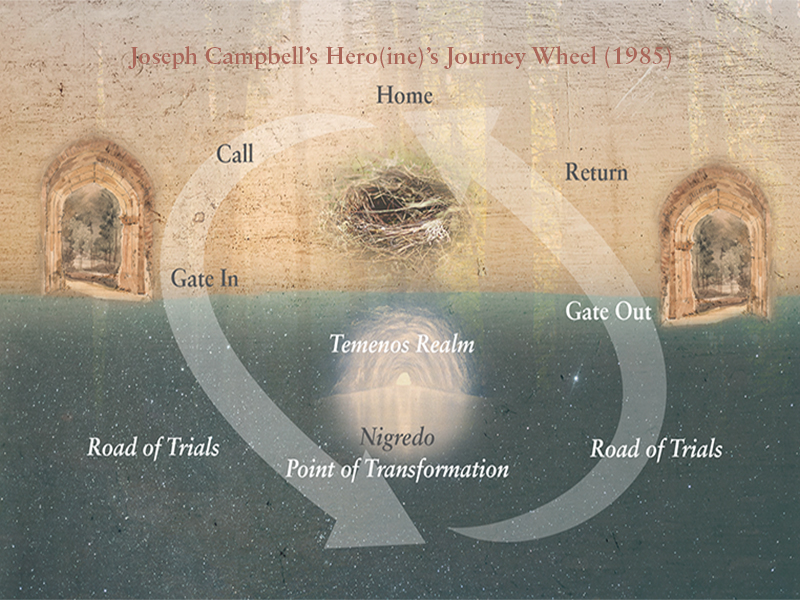In a hole in the ground there lived a hobbit.
– The Hobbit, by J.R.R. Tolkien, line 1, page 1.
The prologue to Tolkien’s Lord of the Rings epic begins at, and returns to, Bilbo’s Home. On the Hero/ine’s Wheel, Home is at the top of the graphic, or North if reading it as a map. Home is where you leave from to begin the Journey. Home is the nest in which you currently reside. It might be physical, but it can also be spiritual, intellectual, cultural… home is not built of brick and mortar.

In Gates In and Out, the play on this site about the Hero/ine’s Wheel, the Storyteller’s opening lines are:
“Once upon a time”… ah, a story begins! At the beginning of a story we are usually here, at “Home”. (Audience member raises sign.)
Home can be anywhere, anytime, anyplace, in the kingdom of… near the forest… in the city.
As the Storyteller I often begin by telling you immediately about the Homeplace, the state of birth, the Status Nascendi, the place where the story begins.
In a Fairy Story the first lines are about the Home Situation. If the opening is “Once upon a time in a kingdom which had no Queen” we know immediately the hero or heroine is going to leave home and solve the problem of no Queen.
Home a physical place: a kingdom. And it is also the Status Nascendi – the birthplace of the state of being: there is no Queen. The Status Nascendi is the state of being that is about to undergo transformation, at least for the person taking the journey.
The Raven Grimm #93
There was once a queen who had a little daughter, who was still too young to run alone. One day the child was very troublesome, and the mother could not quiet it, do what she would. She grew impatient, and seeing the ravens flying ‘round the castle, she opened the window, and said: ‘I wish you were a raven and would fly away, then I should have some rest.’ Scarcely were the words out of her mouth, when the child in her arms was turned into a raven, and flew from her arms away from her through the open window.
Home in The Raven is not the castle but a situation: a troublesome child and a tired mother. A little raven magic, an open window, and the child leaves Home. In this story the Raven Woman and the Hero both make a journey, revolved around each other, and neither return to the original Status Nascendi. Some Journeyers find their original Homes refuse the gift brought back with such labor; they may begin another journey looking for the rightful home, who will receive both the Journey maker and the gift acquired along the Road of Trials.
We all leave one home at birth, and enter this world; our journey encompasses our life, and only at the end of it will we return home. This is a Great Wheel. We also leave our home, perhaps to go to work in the morning, and return to it in the evening. This is a Day Journey, a very small wheel. Even so, the state of being, the Status Nascendi, of the morning gives us our warm-up to the journey ahead of us. Do we leave fed and blessed, or fighting? Do we carry that warm-up into the commute? Into the classroom? When we reach the Gate In are we ready?
My grandchildren attended a Waldorf school, and every morning the teacher met and greeted each student by name, looking in the eyes, shaking hands. The teacher cut across whatever warm-up the child had and they walked into the classroom recognized and connected. At work the supervisor may have a “Stand Up Meeting”, a moment when the team gathers and briefs each other about the work being done. Online meetings often begin with a quick “Check-In”. Having a welcoming Gatekeeper makes a difference in our willingness to begin the day’s Road of Trials. If you are a Gatekeeper for someone, for some project, remember this.
Passages
In the course of our lives there are culturally marked passages where we leave Home. Obvious ones are leaving a parent’s home, graduations, marrying, beginning a career or new job, moving to a different part of the world. These might be labeled transitions, but become transformations if the passage involves integration of a new identity. We still may refer to our parents’ houses as “Home” but in fact we are independent of their care. In many cultures the transformation is observed in a formalized ritual or Initiation process.
And there is the “leaving home” of changing a part of our early upbringing, our training, and choosing a different understanding. Richard Forer in Breakthrough: Transforming Fear into Compassion describes his realization that he had been trained since childhood to think in one way; when he realized he had not been taught the truth, he leaves Home as surely as if he walked out the door. He describes the moment of his revelation as “I died.” People working with their addiction understand this passage. People who say “I’m born again” are naming the transformation point of their journey. On the Hero/ine’s Wheel that place of transformation, the Nigredo, is the opposite pole, the farthest point away from “Home.” On the Wheel, after a transformation, the Journeyer travels towards “Home”, and to reach it ends the journey.
Toxic Homes
Some people live in homes that are toxic. A large percentage of fairy tales open with a description of the parents and siblings who ignore, tease, or actively persecute the Journeyer. They prevent the hero/ine from achieving fulfillment of who they are. In a toxic home the Status Nascendi is defended, and any criticism or suggestion is met with resistance. Any development is seen as endangering the whole family constellation: change one element and each member of the family must change also. So the annoyance is extruded.
It seems possible that people who can’t leave might become a pearl, coating themselves inside the situation with beauty. Emily Dickinson seems a candidate for this, and a friend who lives only in one small part of her home because of toxic chemical aversions.
When people in groups would get too deeply into whining about how toxic the home had been that raised them, Robert Bly would often ask “And what gift did that Home give you?” Often people would name qualities or competencies: resilience, endurance, ducking (physically and metaphorically), resolution. Then Robert would challenge each person to thank the people who created this opportunity for them. There is an AA step that is a parallel to this practice.
Healthy Homes
So, to just flip the qualities from Toxic Homes, a healthy Home:
- encourages exploration
- supports change and development
- recognizes differences
- celebrates diversity
- builds skills for the journeys
- provides a blessing and sustenance for the journeyer
This list is not only something in the outer, physical reality. It is the inner landscape of the Journeyer, the internal Home for the soul. Sometimes a Journey is about the Journeyer’s conversion of a toxic inner landscape to a healthy one.
Homeless
A third of the world’s people live as refugees—not only individuals but whole cultures have been forced to leave their physical home. Global climate changes will increase this number. Solutions to the physical needs of establishing a new Home are being invented and employed. But cultures are based in place; how does a people survive without a home. The Jewish peoples are a long time example. Their ability to maintain their culture without a home made them a threat to the Status Nascendi of the cultures they lived within. “Learn English” is the demand of a defender of the old order. The panhandler is a pointer to a failed system; the defender of the old order wants them out of sight. One program developed in response to widespread homelessness in the USA is called “Homes First”. Here the Journeyer is being offered the chance to establish a Home. May they each be free to explore what that home will be for them after so long on the Road of Trials.
Dear Journeyer:
FROM GATES: (Storyteller To Audience) There will be questions for you from time to time. They help you remember your story. Please answer when asked the question. Here’s the first one: where is Home for you?
Please share comments, questions, reflections, answers.




